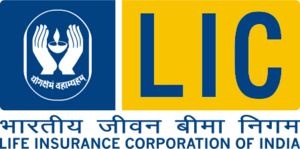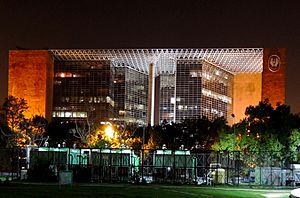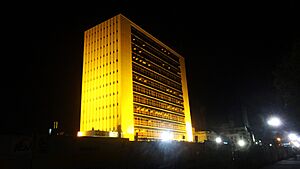Life Insurance Corporation facts for kids

Yogakshemam Vahamyaham
|
|

LIC New Delhi
|
|
| Public | |
| Traded as | |
| Industry | Financial services |
| Founded | 1 September 1956 |
| Headquarters | Mumbai, Maharashtra, India |
|
Key people
|
|
| Products |
|
| Revenue | |
|
Operating income
|
|
| Total assets | |
| Total equity | |
| Owner | Government of India (96.5%) |
|
Number of employees
|
98,661 (2024) |
| Subsidiaries |
|
| Footnotes / references Financials as of 31 March 2025[update]. |
|
The Life Insurance Corporation of India (LIC) is a very large Indian company that provides life insurance. It is based in Mumbai, India. LIC is owned by the Government of India and is the biggest insurance company in India. It also manages a huge amount of money, making it India's largest investor.
LIC was started on September 1, 1956. This happened when the Indian Parliament passed a law to take over all insurance companies in India. More than 245 different insurance companies and groups were combined to form LIC. This made sure that insurance was safe and reliable for everyone in India.
As of 2019, LIC had 290 million policyholders, which means a lot of people trusted them with their insurance. The company also handled 26 million claims in 2018–19, helping many families. LIC is a very important company for India's economy.
Contents
How LIC Started

Before LIC was created, there were many small insurance companies in India. The very first one to offer life insurance was the Oriental Life Insurance Company, started in 1818 in Kolkata. Later, in 1870, the Bombay Mutual Life Assurance Society was formed. It was the first insurance provider from Western India.
Many of these early companies faced tough times. This was because of big events like World War I and World War II. These events made it hard for some insurance companies to stay in business. People sometimes lost trust in getting life insurance.
Becoming a Government Company
In 1956, the Indian government decided to take control of the insurance industry. This was done to make sure that insurance services were fair and trustworthy for everyone. All private insurance companies were brought together under one big government-owned company, which became the Life Insurance Corporation of India. This step helped to build public trust in insurance again.
In 2021, the Indian government announced that it would offer some shares of LIC to the public. This is called an initial public offering (IPO). It meant that ordinary people could buy a small part of LIC. The government wanted to raise money and also allow more people to be part of LIC's success.
The IPO happened in May 2022. The government sold a small part of its ownership in LIC. Since then, LIC's value has grown a lot. By 2024, LIC's shares reached very high values. This showed that investors had a lot of confidence in the company.
How LIC Works
LIC's main office is in Mumbai. It also has 8 big regional offices called zonal offices. These are located in major cities like Delhi, Chennai, Hyderabad, and Kolkata. These offices help manage LIC's work across the country.
Opening Up to Other Companies
Around the year 2000, the Indian government allowed private companies to offer insurance services again. This meant that LIC now had competition. However, LIC continued to grow strongly. It showed that it could do well even with other companies in the market.
Helping the Community
In 2006, LIC started the Golden Jubilee Foundation. This is a charity organization that helps people. Its main goals are to support education, help reduce poverty, and improve living conditions for people who are not as fortunate.
One of the most well-known things the foundation does is the Golden Jubilee Scholarship award. Every year, this scholarship helps bright students who have finished 12th grade and want to continue their studies. It helps students whose families earn less than a certain amount of money.
What LIC Invests In
LIC invests a lot of money in different parts of the Indian economy. It puts money into banks, construction companies, and businesses that make things like cement and chemicals. It also invests in electricity, electronics, and even hotels. This helps these industries grow and creates jobs. LIC also invests in technology, metals, mining, and transportation.
More to Explore
- Insurance in India
- Insurance
- LIC Housing Finance

